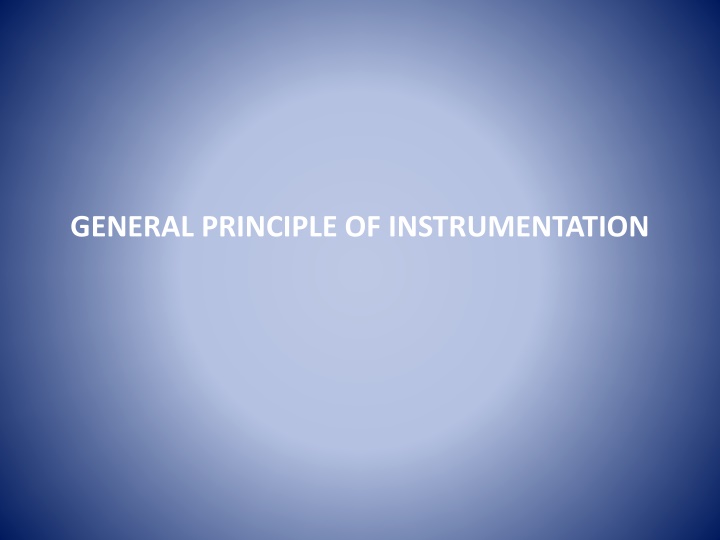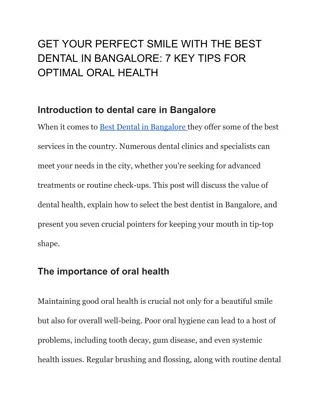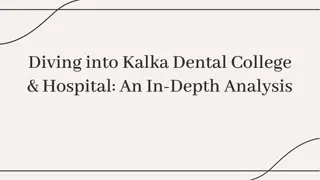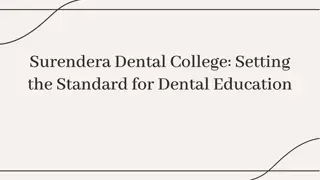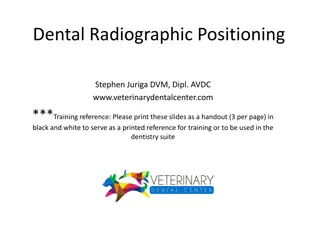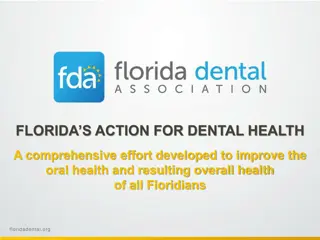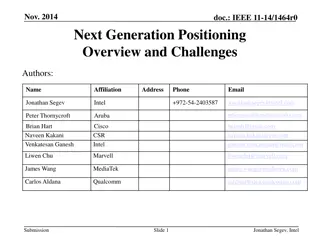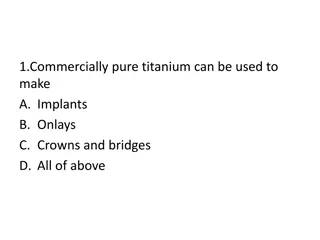Principles of Dental Instrumentation and Patient Positioning
Understanding the general principles of dental instrumentation is crucial for efficient dental procedures. This includes aspects such as instrument activation, maintaining a clean field, and proper positioning of the operator and patient for optimal visibility and accessibility. Attention to detail in instrument stabilization and stroke, as well as patient positioning on the dental chair, contributes to the success of dental treatments.
Download Presentation

Please find below an Image/Link to download the presentation.
The content on the website is provided AS IS for your information and personal use only. It may not be sold, licensed, or shared on other websites without obtaining consent from the author.If you encounter any issues during the download, it is possible that the publisher has removed the file from their server.
You are allowed to download the files provided on this website for personal or commercial use, subject to the condition that they are used lawfully. All files are the property of their respective owners.
The content on the website is provided AS IS for your information and personal use only. It may not be sold, licensed, or shared on other websites without obtaining consent from the author.
E N D
Presentation Transcript
INTENDED LEARNING OBJECTIVES Accessibility Visibility, illumination and retraction Condition of instruments Maintaining of clean field Instrument stabilization Instrument activation Instrument stroke Scaling and root planing
ACCESSIBILITY Position of operator The clinician should be seated on a comfortable operating stool that has been positioned so that- Head is relatively erect. Head in the least strained position vertically and horizontally. Eyes are directed downward in a manner that prevents head and neck strain. Distance from patients mouth to the eyes of clinician should be 14-16 inches.
Shoulders are relaxed. Fore arm and wrist are kept in straight line, wrist is neither flexed nor extended. Body weight is completely supported by chair. Back is straight and erect. Thighs should parallel with floor. Feet should flat on the floor.
The patients chin is at 6 O clock. The right handed clinician sits between 9 and 12 O clock. The left handed clinician sits on opposite side between 12 to 3 O clock.
Position of the patient For maxillary arch- The patient should be asked to raise the chin slightly to provide visibility and accessibility. For mandibular arch- It may be necessary to raise the back of chair slightly and request that the patient lower the chin untill the mandible is parallel to the floor.
Assistant is seated with eye level 4-6 inches above the clinician s eye level and facing towards the head of the dental chair.
The various positions of the patients on the dental chair- Upright initial position from which chair position are made. Semiupright- respiratory and cardiovascular patients. Supine- flat position with head and feet are on the same position. Trendlenburg- modified supine position when the head is lower than the heart. The brain is lower than heart and feet slightly elevated.
VISIBILITY, ILLUMINATION AND RETRACTION Direct vision and direct illumination from dental light is most desirable. If this is not possible, indirect vision may be obtained by using mouth mirror and indirect illumination may be obtained by using the mirror to reflect the light to where it is needed. Indirect vision and indirect illumination are often used simultaneously.
Retraction provides visibility, accessibility and illumination. Fingers and/or mirrors are used for retraction. Use the mirror to deflect the cheek, while the fingers of non operating hand retract the lips and protect the angle of mouth from irritation. Use the mirror alone to retract the lips and cheek. Use the finger of non operating hand to retract the lips. Use mirror to retract the tongue. Combination of the preceding methods. EFFECTIVE METHODS FOR RETRACTION
Direct vision and direct illumination Indirect vision and indirect illumination
Retraction by index finger Retraction by mouth mirror
While retracting care should be taken to avoid irritation to the angle of the mouth. If the lips and skin are dry, softening the lips with petroleum jelly before instrumentation is helpful precaution against cracking and bleeding. Careful retraction is especially important for a patient with history of recurrent Herpes Labialis because these patient may easily develop herpatic lesions after instrumentation.
CONDITION AND SHARPNESS OF INSTRUMENT Steps in the effective care of instrument Instruments are cleaned after each use by removing blood and debris under running water. The instruments are sharpen regularly and sharpness is checked thereafter. Instruments are sterilized thoroughly.
MAINTAINING CLEAN FIELD Operating field is obscured by saliva, blood and debris. To avoid Adequate suction is essential and can be achieved with saliva ejector, aspirator or suction.
Blood and debris can be removed by suction or by wiping or blotting with gauze piece. Compressed air and gauze squares can be used to facilitate visual inspection of tooth surfaces just below gingival margin.
Q.1. Aerosols are produced by: (A) magnetostrictive scaler (B) Sonic scaler (C) peizo electric scaler (D) all of the above
Q.2. Chair position in pregnant patient: (a) supine (b) Semisupine (c) Trendelenberg (d) Left lateral
Q.3. Most common used finger for retraction is: (a) Thumb (b) middle finger (c) Index finger (d) Ring finger
Q.4. in which trimester of pregnancy the periodontal treatment is considered to be safe: (a) first (b) second (c) third (d) in any of trimester
Q.5. The distance from patients mouth to the eyes of the clinician: (a) 12-14 inches (b) 14-16 inches (c) 16-18 inches (d) 18-20 inches
